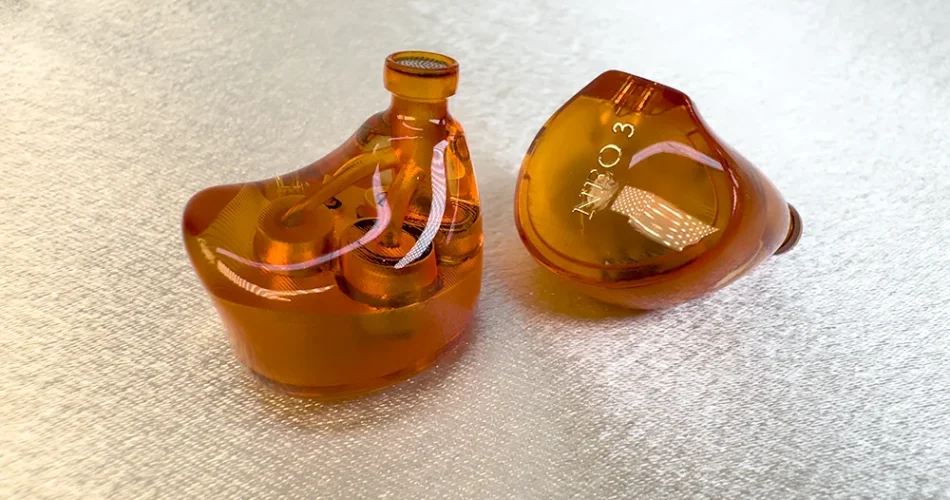IEM Comparisons

I compared the Neo3’s with several IEMs at hand, using my Astell & Kern SR35 in high-gain mode, with the Neo3s requiring a volume level of 35.
ISN Neo1 – 1xDD (USD $39)

Despite being only slightly smaller the Neo1 shells are significantly lighter, and also tend to be more slender in the areas that contact directly with my canals so I find them much more comfortable than the Neo3s. Needing 35 volume on the SR35 they’re similarly easy to drive.
The Neo1s are budget single-driver IEMs and that’s immediately apparent with their lower resolution, narrower & flatter stage, and inability to render individual instruments as distinctly during busy passages of music as effectively as the multi-driver Neo3s can.
The Neo1s are very coherent, but possess less bass quantity than the Neo3s and bass texture isn’t as satisfying either. Note weight is lower and dynamics are poorer, they’re actually more neutral with less warmth than the Neo3s and feel a little brighter but less like bonafide basshead IEMs than the Neo3s do.
NiceHCK F1 Pro – 1xPlanar (USD $99)

The F1 Pros are slightly smaller than the Neo3s with similar weight, and feel a bit less snug in my ears which improves comfort. Needing 47 volume on the SR35 they’re a bit harder to drive.
Far more V-shaped, the F1 Pros are much brighter and I find their treble jumps out from the rest of the frequency spectrum quite a bit. The Neo3s have a lot more lower midrange warmth whereas the F1 Pros can sound quite cool & clinical.
The F1 Pros’ soundstage is wider but flatter, bass does not go as deep and I find their bass texture a little pillowy. The Neo3s are much thicker with better note weight, are smoother & more relaxed and more bass dominant. Imaging feels a touch clearer on the Neo3s and resolution between the two is fairly similar.
Simgot EA1000 – 1xDD 1xPR (USD $219)

The EA1000s are smaller but quite a bit heavier due to their stainless steel shells, but I do find their shape more comfortable. Requiring 28 volume on the SR35 they’re very easy to drive.
The EA1000s have a more excited v-shaped tuning that’s much brighter than the Neo3s, with a thinner & cooler sound that emphasises the upper midrange more. EA1000 bass quantity is lower and bass texture isn’t as satisfying, vocals don’t have as much weight behind them but do feel more articulate.
Resolution & dynamics are slightly higher on the EA1000s and their drivers seem slightly quicker to respond, but the Neo3s are more musical & less fatiguing.
ISN Neo5 – 4xBA 1xDD (USD $289)

The Neo5 shells are similarly sized but thinner in the parts that make contact with the canals so I find them significantly more comfortable. Needing 30 volume on the SR35 they’re easy to drive.
The Neo5s’ DD is more sluggish which has the benefit of making bass decay slower & more satisfying, but means they have more trouble keeping up with faster music than the Neo3s. Bass quantity is even higher on the Neo5s and bass texture is better, and they’re more v-shaped & brighter overall.
Neo5s dynamics are much more apparent, their soundstage is slightly deeper but similarly wide, and they’re a bit more resolving. The Neo5s are more exciting but possibly too much so if you’re treble sensitive whereas the Neo3s are smoother, more politely tuned and warmer.
Penon Quattro – 4xDD (USD $399)

They’re similarly sized but the Quattros are a little bit heavier and stick out more, but I find comfort of the two IEMs is similar. Needing 50 volume on SR35 the Quattros are more difficult to drive.
To my surprise the Quattros are actually less warm & relaxed than the Neo3s, but boast higher bass quantity and their bass texture is also more satisfying. The Quattros’ midrange is more forward & aggressive but also more resolving and refined, and upper treble also feels more prominent.
The Quattros are more dynamic, have a blacker background with sharper imaging and a far deeper soundstage, though it is narrower than the Neo3’s.
Page 1 – Introduction, Packaging & Ergonomics
Page 2 – Sound Impressions & Technical Performance
Page 3 – IEM Comparisons
Page 4 – Cable Comparisons
Page 5 – Conclusion


Comments